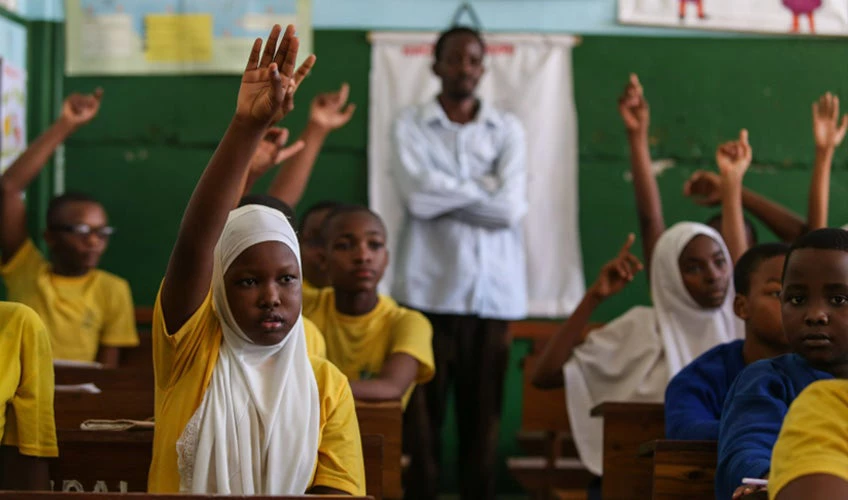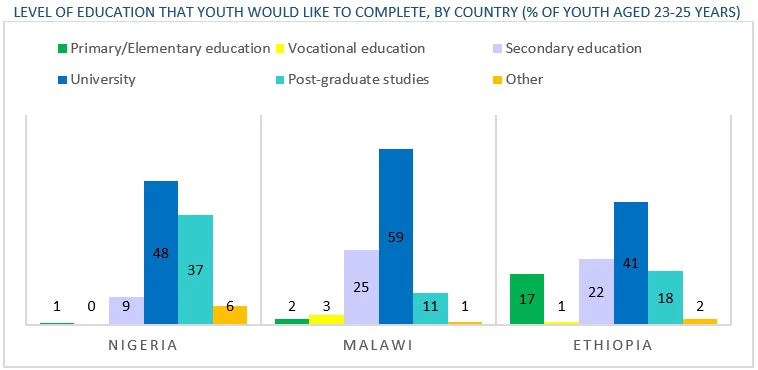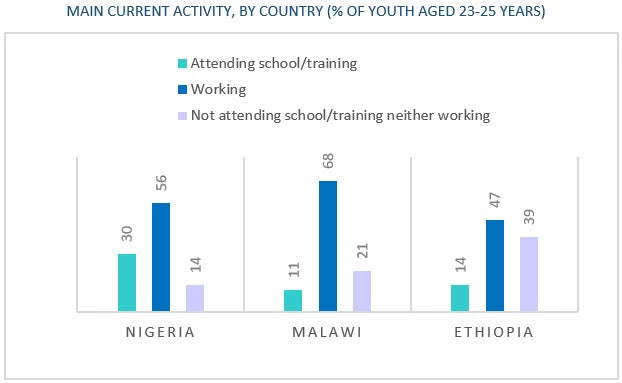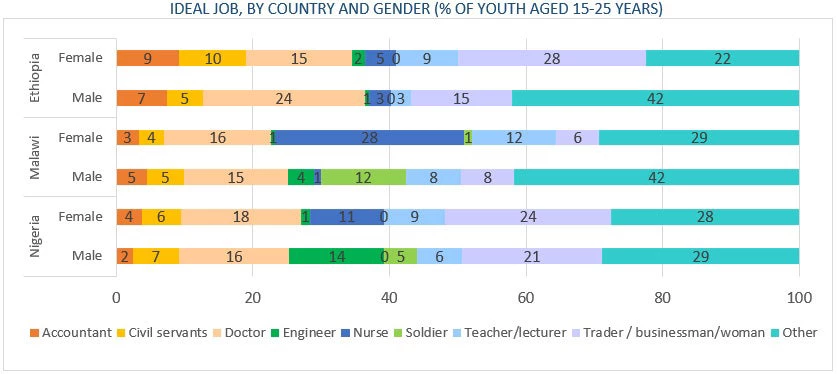
Understanding the aspirations and goals of the youth is essential to developing effective employment policies. Aspirations can drive choices in education, employment, and job-seeking efforts. During the current COVID-19 pandemic, young people faced simultaneous labor market challenges that could lead to modify their aspirations. If changes on aspirations and life goals are not considered, policies aiming to match skills with labor market opportunities may continue to fail young people between the ages 15 and 25, a group that accounts for roughly 20% of the population in Sub-Saharan Africa. This highlights the urgent need to capture data on the current status of youth aspirations in three Sub-Saharan African countries.
As part of the COVID-19 high-frequency phone surveys (HFPS) program, the Living Standards Measurement Study (LSMS) team developed the education history, work history, future plans and career aspirations questionnaires,[i] relatively to in Ethiopia (June 2020), Malawi (June 2020) and Nigeria (April 2020).[ii]
Findings show that a large share of youth aged 23-25 years reported higher educational aspirations than their current academic achievements. On average, 40% of youth aged 23-25 years in Malawi and Ethiopia have not yet completed universal primary schooling, while 51% of their Nigerian peers have attained the secondary school qualification as the highest degree. However, when asked about their ideal level of formal education, assuming no barriers exist, 85% of Nigerian youth aged 23-25 years reported their desire to complete either a university degree or post-graduate studies, compared to 70% and 59%, respectively, of youth in Malawi and Ethiopia.

The HFPS data also reveal that the share of youth aged 23-25 years currently working in their ideal job is lower than 40%. Across the three countries, having a high salary and doing an interesting job are considered by youths to be the primary characteristics of the ideal job.

We further observe high rates of young people aged 23-25 years who are neither studying nor working (NEETs). Specifically, Ethiopia reports the highest rate of NEETs among youths aged 23-25 years (39%) compared to their Nigerian (14%) and Malawian peers (21%). The share of NEETs is higher amongst female than amongst male youth in all countries.
Why did young people fail reaching their aspirations? The lack of money is the most reported reason for unrealized aspirations, both in terms of educational level and professional realization.
Finally, we see significant gender differences in youth career aspirations across the three countries that may depend on the exposure to traditional gender roles, patriarchal values, and cultural expectations. Female youth more commonly report being interested in pursuing a career in nursing or teaching, while male youth usually aspire to be engineers or soldiers. Furthermore, career aspirations for jobs in engineering, which require higher levels of education and technical skills, are mostly reported in urban as opposed to rural areas.

In conclusion, measuring youth aspirations helps shed light on the possible employment outcomes that can be observed in adulthood and plays a role in breaking poverty circles, which is highly relevant for public policy. Improved data collection supports the targeted design of policies to answer specific questions, such as what the right age is to intervene – if the goal is to help shape aspirations, amongst others. Including an aspirations module on panel surveys can help to identify aspirations over time and link them with household characteristics. By collecting data at the individual level in multi-topic household surveys, we will be able to identify different characteristics of the youth and their families and to help understanding how aspirations shape the youth future.
Further research may explore how aspirations change with respect to age, shocks, and coping mechanisms. In addition, understanding the link between current youth aspirations and family factors, i.e., the educational achievements of their parents or the socio-economic background of the household, may contribute to a more robust discussion around policies intended to match aspirations with job opportunities.
Resources:
- Read the full brief for more on the mechanisms behind these changes in educational and job aspirations in Ethiopia, Malawi and Nigeria
- The piloted version of the questionnaire is available here
- Find out more about the LSMS-supported COVID-19 high-frequency phone surveys
[i] This questionnaire was drafted based on recent household surveys: the ILO SWTS questionnaire (2009), Module 2; the World Bank Young Basotho's Aspirations and Challenges Survey (2019); and Young Lives, round 4, Ethiopia (2013-2014).
[ii] The sample of youth respondents was randomly selected among the household members aged between 15 and 25 years. A uniform methodology was adopted in sampling, data collection, and weighting across the three countries, to make cross-country comparison feasible. The sample size is 841 youth in Nigeria, 910 youth in Malawi and 881 youth in Ethiopia.




Join the Conversation